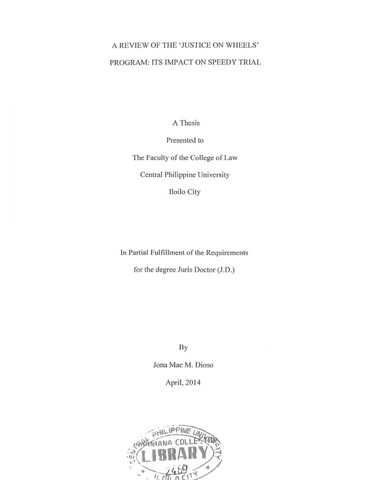A review of the ‘justice on wheels’ program: Its impact on speedy trial
| dc.contributor.adviser | Alibogha, Salex E. | |
| dc.contributor.author | Dioso, Jona Mae M. | |
| dc.date.accessioned | 2021-02-09T09:48:12Z | |
| dc.date.available | 2021-02-09T09:48:12Z | |
| dc.date.issued | 2014 | |
| dc.identifier.citation | Dioso, J. M. M. (2014). A review of the ‘justice on wheels’ program: Its impact on speedy trial (Unpublished postgraduate thesis). Central Philippine University, Jaro, Iloilo City. | en_US |
| dc.identifier.uri | https://hdl.handle.net/20.500.12852/251 | |
| dc.description | Abstract only | en_US |
| dc.description.abstract | Most people in every part of the world seek for justice. Justice, however, is sometimes delayed by the clogging of court dockets or lack of court. In response to the situation, the ‘Justice on Wheels’ Program was implemented. It was adopted and launched in the Philippines in 2004. The program aimed mainly at declogging court dockets by supplying mobile complementary courts and mobile substitute courts. It was later re-launched in 2008 under the name ‘Enhanced Justice on Wheels' Program. The new program added mediation services and legal aid clinics for underprivileged litigants. It also provided free medical and dental aid for the detainees and facilitated information dissemination drives on the justice system. The mobile courts were designed to travel to every place where there is no court or access to courts is highly remote. They were also made as substitute for courts which were under renovation and as complementary for those which dockets are clogging. In implementing the program, the mobile courts made their pilot mission as complementary courts to those which dockets are clogging. Regular courts were selected and made to prepare the promulgation of terminating cases to be done in the mobile courts. The judges of the selected courts promulgated their terminating cases in the mobile courts and included the numbers as cases resolved through the ‘Enhanced Justice on Wheels’ Program. Typhoon - affected areas which courts were damaged were also visited by the mobile courts. Records were temporarily transferred to mobile courts and judges and other court personnel continued to discharge their function in the mobile courts. | en_US |
| dc.format.extent | ii, 38 leaves | en_US |
| dc.language.iso | en | en_US |
| dc.subject.ddc | GSL Theses 340.72 D624 | en_US |
| dc.subject.lcsh | Court administration | en_US |
| dc.subject.lcsh | Justice, Administration of | en_US |
| dc.title | A review of the ‘justice on wheels’ program: Its impact on speedy trial | en_US |
| dc.type | Thesis | en_US |
| dc.description.bibliographicalreferences | Includes bibliographical references | en_US |
| dc.contributor.department | College of Law | en_US |
| dc.description.degree | Juris Doctor | en_US |
| local.subject | Justice on wheels | en_US |
| local.subject | mobile complimentary courts | en_US |
| local.subject | Legal aid | en_US |
| local.subject | Underprivileged litigants | en_US |
Files in this item
This item appears in the following Collection(s)
-
Juris Doctor [144]


